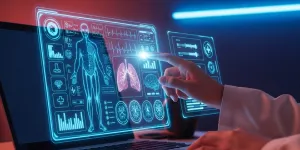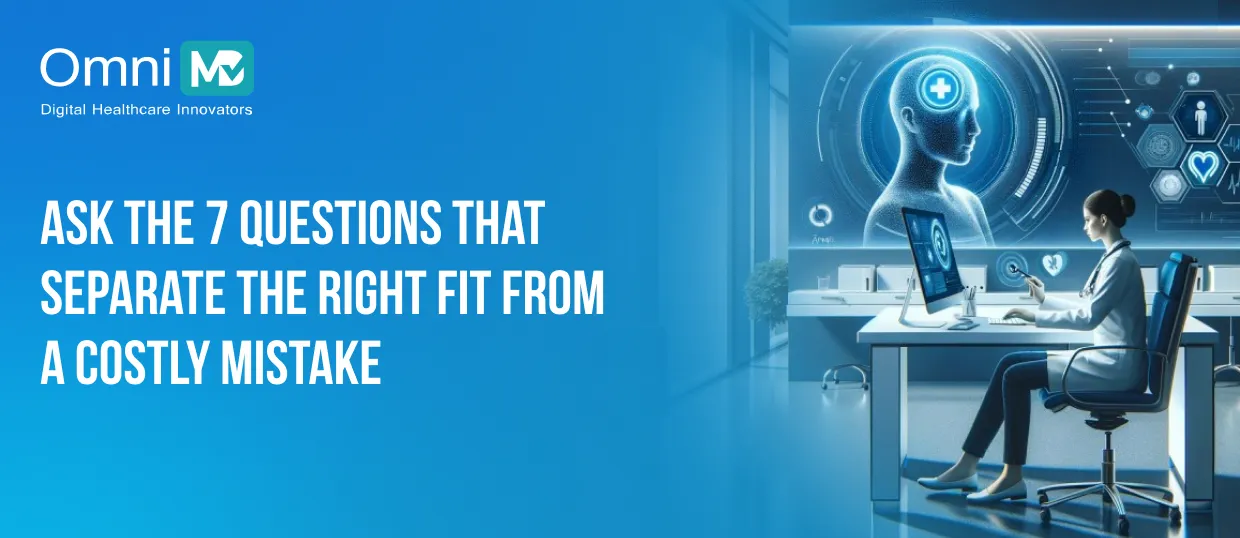AI Scribe Selection: 7 Smart Questions Clinicians Must Ask
One of the busy family medicine physicians, Dr Smith, ends her clinic day with six unfinished notes. Similar to this, a cardiologist down the hall faces the same problem: documentation creeping into evenings. Meanwhile, a psychiatrist in the same facility spends an extra two hours every Friday finishing mental status exam notes.
The culprit? Administrative overload.
What’s the ideal solution for this? AI medical scribes are an ambient, intelligent system that listens, construes, and documents medical encounters straight into the EHR.
But not all AI scribes are developed equally. A system perfect for cardiology may not work for podiatry, or an excellent orthopaedic surgery system may fail in psychiatry, where nuance in patient statements matters. A podiatrist may require image integration, while OB-GYNs may need thorough prenatal history templates.
Hence, it is essential to ask the right questions before investing in AI medical scribes to understand beyond marketing claims and determine whether the AI scribe accurately fits your specialty, workflow, and compliance requirements.
Why an AI Medical Scribe?
Studies show that U.S. physicians spend about 16 minutes per patient encounter actively using the electronic health record (EHR), a time that includes chart review, documentation, and order entry. One large-scale study conducted in 2020 analyzed roughly 100 million outpatient encounters across 155,000 physicians, revealing this substantial time allocation.
Yet another recent research paints a clear and troubling picture of the growing documentation burden on U.S. clinicians. According to AMA guidelines, in primary care, clinicians spend an average of 36.2 minutes per patient visit on the EHR, which includes about 6.2 minutes in post-work hours and 7.8 minutes on inbox tasks.
This workload is not just an inconvenience. It’s a continuing drain on revenue, clinical capacity, and provider well-being. The consequence is less time with patients, delayed note completion, and a higher risk of burnout.
AI medical scribes have emerged as a viable, often transformative solution, reducing documentation time by up to 70–80%, improving note accuracy, and giving clinicians back their evenings.
However, not every AI scribe is built to handle the specific language, workflows, and compliance demands of your specialty. The wrong choice could create more work, not less.
That’s why, before signing a contract, you need to go beyond vendor brochures and ask questions that uncover whether the scribe will truly deliver value in your environment. The following 7 smart questions are designed to guide you through that decision-making process, ensuring you select an AI partner that will improve, not disrupt your practice.
- Is AI Scribe accurate in my specialty?
Due to the conversational nuances, an AI scribe that is 95% accurate for Pediatric care may drop to 80% in psychiatry, or an AI scribe that has 90% accuracy for primary care may drop to 80% in performance for cardiology due to technical terminology. Often, 95% claims hide the reality of performance drops in specialties with unique language and workflows.
This question is key because the accuracy has a direct influence on patient safety, legal defensibility, and billing integrity. As clinical decisions rely on precise notes, it’s essential for an AI scribe to ensure that no subtle symptom or lab information is lost in translation.
Here’s an example of a specialty note:
- Psychiatry: Check for accuracy in capturing emotional descriptors and patient narratives.
- Cardiology: Confirm accurate capture of investigative metrics like ejection fraction, valve gradients, etc.
- Podiatry: Check for crucial surgical notes for anatomical terms for foot and ankle structures.
Also, check for the transparency a vendor provides in case of errors, audit trails, and reporting.
- Does it seamlessly integrate with EHR or RPM platform?
Essentially, AI scribes vendors ensure that their tool automates the documentation but end up with just recordings & transcripts that don’t reflect on EHR, hence defeating the purpose of automation.
It is essential to ask this question because native or API-based integration means that the provider notes flow directly into EHR, pre-populating applicable fields and attributing to the correct patient chart without extra clicks. For tele-visits/ telehealth, it is critical to take real-time notes so that the provider can avoid switching between multiple windows. Ensure that specialty notes are displayed against each patient’s information.
For example, if you are a Gynaecologist and OB-Gyn practice, ensure that imaging reports are attached and are available as reference within the visit note.
- Is it possible to control and customize the output?
Clinicians have different preferences; some want SOAP notes, while others prefer narrative style. Hence, it is essential to ensure that the AI scribe you are selecting for your practice must allow customization like:
- Locking sensitive sections so that it doesn’t auto-edit
- Adding “smart phrases” for common conditions
- Modify templates for explicit visit types, for example, a template for prenatal visit vs. postpartum check
Here’s how you can check. If you are a family medicine provider, you take care of a range of conditions in a day. Hence, you can check for customisation that ensures all note types are aligned with billing and clinical requirements.
- If the AI Scribe support real-time and asynchronous modes?
If you are an urgent care specialist, your documentation style may vary as you want real-time summaries for immediate decision making. Or if you are a psychiatry practice, asynchronous notes (created after the session) would provide a better contextual accuracy.
This question must be on your priority list as having both options for asynchronous notes and real-time summary ensures the AI scribe is well adapted to your specialty workflow.
- Data Ownership and if it is transferable?
Your clinic notes are intellectual property and are an integral part of your legal medical record. Check with your AI scribe vendor if you can export your data in usable formats like HL7, FHIR, JSON, TXT without forfeits. This is important in case the vendor shuts down or if you wish to switch providers in the future, your data is within your care.
For example, suppose you are a multi-location specialty group like pediatrics, primary care, orthopedics, or women’s health networks. In that case, you should confirm constant data portability across multiple sites to sustain uniformity in patient records.
- Is training and support provided?
AI tools are indeed meant to ease the efforts but even the most advanced AI tool will lead to confusion without proper training and support. Always check if the vendor offers live training, 24/7 support, and quick response times, preferably less than 5 minutes for crucial issues. This reduces downtime and keeps a continuous clinical flow. Ensure you seek specialty specific training & support.
Please note, for smaller practices, typically solo psychiatry, podiatry, or new primary care clinics, the vendor must provide immediate support, as any delay could halt patient care.
The Way Forward- Do not just adopt the AI Scibe, go for the right AI scribe
There are unique documentation challenges faced by each specialty. However, the basis of an excellent AI scribe is widespread. It assures accuracy, security, seamless integration, customization, guarantees ownership and provides flexibility and support. Picking an AI medical scribe is not just a technology purchase. It is an operational, clinical and a strategic decision that has a direct impact on the future of your practice.
The 7 smart questions outlined here are not just checklist but safeguard for your practice. Each question can assist you to see beyond the marketing bywords, expose any hidden gaps, and let you know whether a scribe is able enough to handle the realities of your specialty, compliance requirements and workflow.
The risk of ignoring these questions may lead to paying for a tool that slows you down, getting notes that no longer serves critical clinical details, leads to integration headaches, and compromising patient data security and ownership. It frustrates your staff and providers ending up in losing patient trust and you might also face compliance violations.
The OmniMD AI Medical Scribe is built to exactly sound like the principles required for clinical control, airtight security and compliances, seamless integration and specialty-specific intelligence. No matter what your specialty is, we ensure effortless, secure & accurate.

Find Your Perfect AI Scribe
Ask these 7 questions before you decide.

 Written by Neha Singh
Written by Neha Singh
 Reviewed by Shivani Joshi
Reviewed by Shivani Joshi